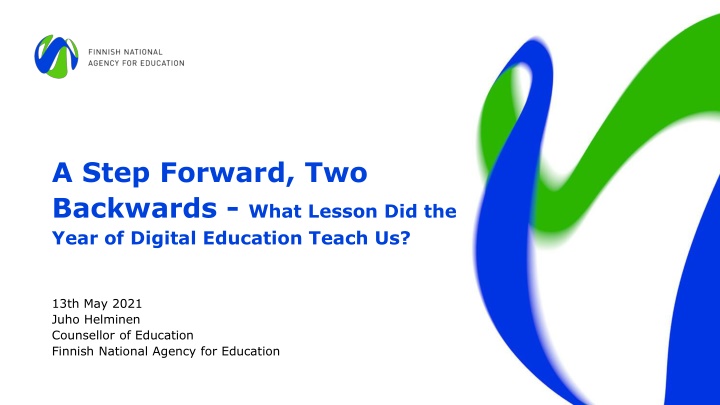
Lessons Learned from the Year of Digital Education in Finland
Explore the challenges and opportunities faced by Finnish education during the COVID-19 pandemic, highlighting the importance of digitalization, teacher coping strategies, learner support, and lessons for the future. Learn about the need for a national digitization strategy, improving digital ecosystems, enhancing teacher resilience, and fostering community collaboration.
Download Presentation

Please find below an Image/Link to download the presentation.
The content on the website is provided AS IS for your information and personal use only. It may not be sold, licensed, or shared on other websites without obtaining consent from the author. If you encounter any issues during the download, it is possible that the publisher has removed the file from their server.
You are allowed to download the files provided on this website for personal or commercial use, subject to the condition that they are used lawfully. All files are the property of their respective owners.
The content on the website is provided AS IS for your information and personal use only. It may not be sold, licensed, or shared on other websites without obtaining consent from the author.
E N D
Presentation Transcript
A Step Forward, Two Backwards - What Lesson Did the Year of Digital Education Teach Us? 13th May 2021 Juho Helminen Counsellor of Education Finnish National Agency for Education
Situation pre-Covid The Finnish National Agency for Education the main responsibilities are national core curricula from early childhood care up to upper secondary and vocational education, the development of education and support for providers of education. The Finnish system is based on a high autonomy of education providers as well as teachers. Finland had, on average, a good digital infrastructure and good coverage of digital tools and learning environments before the pandemic. The general upper secondary education is already better equipped than basic education. All students have laptops, and a large portion of learning materials are in digital format. The matriculation exam is digital. The vocational education is also fairly well digitalized. However, there are variations between providers of education and schools in the amount and quality of digital equipment, the intensity and practices in the use of ICT and the competence of teachers and students. We have been concerned about the digital divide in education before the pandemic
Observations Early childhood care units were mostly open during the pandemic. Schools were also open to lower grades of primary school those with special needs. Self-regulation skills have a major impact on students learning, self-perception as learners, attendance to distance education etc. There were large differences in distance learning practices between schools, especially in basic education. The availability of the teacher and, the form and number of exercises, assessment and sufficient communication have been key issues. In all, the amount of real-time live-teaching via video connection has been too low during the exceptional arrangements. Teachers still lack the appropriate tools to organize distance learning. The situation is most challenging in basic education. The digital divide between municipalities, schools and teachers and the uneven dispersion of resources and capacities existed before the pandemic and has had a direct effect on the overall success of hybrid education. Teacher Coping - new workload for teachers from learning new skills and methods, reaching students, communicating and giving feedback to each student, and communicating outside of class. Hybrid teaching has been very demanding and cumbersome. Learner coping - maintaining motivation, self-regulation, varying resources, workload mismatch, and lack of forms of support. On the positive side? Parents have been forced to participate in the school activities during distance education. Could this result in better involvement and dialogue in the future?
Lessons for the future A need for a national digitization strategy for education with clear objectives, steps and responsibilities a framework for the digitalization of education is being prepared by MOE. Harmonization and simplification of the digital ecosystem of education better interoperability of platforms, tools and services (example: the DigiOne project) Building a better resilience the school community and its capacity in innovations and problem-solving, collaboration and peer support of teachers, investments in teachers basic and in-service training. Schools should open doors to surrounding community even more and build a good dialogue with families. National recommendations for the minimum level of digital equipment and infrastructure, with emphasis on digital pedagogy device-centricity to be avoided. Procuring devices is just a small part of the solution. How to organize support and funding? New literacies -program: version 1 of a national framework for digital competences of learners published (ICT skills, media literacy and programming) from early childhood care to 9thgrade. What are the implications of the Covid lessons on the national core curricula? Could distance education be of help in organizing education in rural areas where population is decreasing? Both teachers and students have learned a lot of new digital skills and methods. Teachers have received a lot of support from other teachers and the school community. The crisis has tightened collaboration. There is clearly a momentum for a leap in the pedagogical use of ICT in education. All measures taken should be based on research and evidence. For example: a research on the effects of the pandemic, Report on education during the pandemic by the Finnish National Agency for Education

